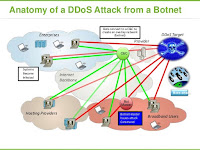
It has been observed that the variants of a new malware named as "Mirai" targeting
Internet of Things(IoT) devices such as printers, video camera, routers, smart
TVs are spreading. The malware is capable of scanning the network devices or
Internet of Things and try to compromise these systems especially those
protected with defaults credentials or hardcoded username passwords.
The malware is capable of performing the following function:
- Compromise
IoT systems with default username and passwords
- Create
botnets of the compromised devices.
- Use
compromise devices to launch DDoS attacks.
- Make
network connections to receive commands from launch further attacks.
It is also reported that the malware resides in memory of the
infected device and can be wiped out by simply rebooting of the compromised
device. However, the malware scans the vulnerable devices constantly leading to
the re-infection of the rebooted device within minutes of reboot.
It is also reported that the malware resides in memory of the
infected device and can be wiped out by simply rebooting of the compromised
device. However, the malware scans the vulnerable devices constantly leading to
the re-infection of the rebooted device within minutes of reboot.
Mirai
Malware Package:
The Mirai malware source code has been publically released which
is written in C language. The main components of the malware are:
- Call-home
routine: This module is responsible for making network connections to
command and control server. This module is executed initially on the
compromised IoT device which then connects to the command and control
server to receive attack information.
- Set
of attack routines: These routines generates network traffic to choke
victim's network capacity.
- Network
Scanner routine: Scans the victims network to discover other vulnerable
IoT devices across the network and report the list of such devices for further
compromise and launching attacks.
Command
and Control Tool:
The malware makes a use of command and control tool named as
"cnc" written in "Go", which provides cross platform
support including seven different computer architecture for both 32 and 64-bit
intel chips, AMD and MIPS chips for common home IoT devices. The malware is
designed to run on regular computers as well as on hardware devices.
Mirai's malware default username/password list used for scanning
vulnerable IoT devices is shown below:
Indicators
of compromise:
- Abnormal
traffic on port 2323/TCP and 23/TCP as it scans for vulnerable devices.
- Command
and Control Network traffic on port 48101/TCP.
- Huge
outbound traffic if the device is part of DDoS attack.
Countermeasures
for securing IOT devices:
- Restrict
Web Management Interface access of IoT devices to authorized users only
and change default username/passwords
- Always
change Default login credentials before deployment in production.
- Change
default credentials at device startup and ensure that passwords meet the
minimum complexity.
- Disable
Universal Plug and Play (UPnP) on IoT devices unless absolutely required.
- Users
should be aware of the installed devices and their capabilities. If a
device comes with a default password or an open Wi-Fi connection, users
should change the password and only allow it to operate on a home network
with a secured Wi-Fi router.
- Control
access to the devices with Access List
- Configure
devices to "lock" or log out and require a user to
re-authenticate if left unattended
- Identify
systems with default passwords and implement abovementioned measures. Some
the systems that need to examined are Routers, switches, web applications
and administrative web interfaces, ICS systems, Telnet and SSH interfaces
- Implement
account lockout policies to reduce the risk of brute forcing attacks.
- Telnet
and SSH should be disabled on device if there is no requirement of remote
management
- Configure
VPN and SSH to access device if remote access is required.
- Configure
certificate based authentication for telnet client for remote management
of devices
- Implement
Egress and Ingress filtering at router level.
- Report
suspicious entries in Routers to your Internet Service Provider
- Keep
up to date Antivirus on the computer system
- Keep
up-to-date on patches and fixes on the IoT devices, operating system and
applications.
- Unnecessary
port and services should be stopped and closed.
- Logging
must be enabled on the device to log all the activities.
- Enable
and monitor perimeter device logs to detect scan attempts towards critical
devices/systems.
Countermeasure
for preventing DDoS attacks:
- Identify
critical services and their priority. Develop Business Continuity Plan.
- Deploy
appropriate Intrusion/DDoS Prevention System capable of detecting and
mitigating DDoS attacks.
- Ensure
that Intrusion/DDoS Prevention System contain signatures to detect the
attacks launched from common DDoS tools.
- Maintain
list of contacts of ISPs, vendors of network and security devices and
contact them as appropriate
- Understand
your current environment, and have a baseline of the daily volume, type,
and performance of network traffic.
- Review
the traffic patterns and logs of perimeter devices to detect anomalies in
traffic, network level floods (TCP,UDP, SYN, etc) and application floods
(HTTP GET)
- Maintain
and regularly examine logs of webservers to detect malformed
requests/traffic.
- In
case your SLA with ISP includes DDoS mitigation services instruct your
staff about the requirements to be sent to ISP.


0 comments:
Post a Comment